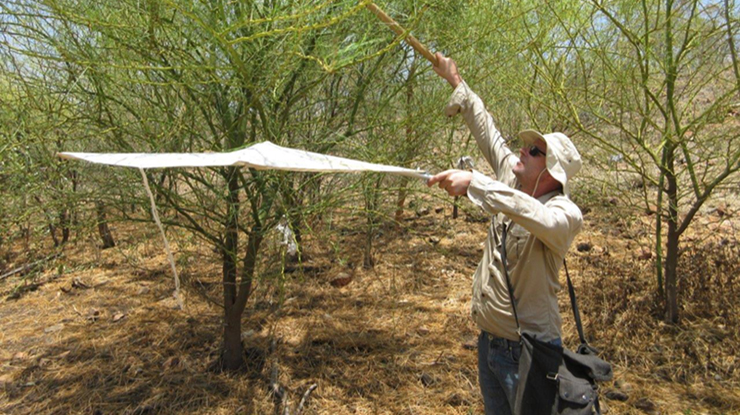 CSIRO officer, Andrew White, using a beat sheet to check for larval establishment of biocontrol moths at a UU2 release site.
CSIRO officer, Andrew White, using a beat sheet to check for larval establishment of biocontrol moths at a UU2 release site.
Solving northern Australia’s Parkinsonia problem
In 2018, an MLA-funded a biocontrol research project with CSIRO was undertaken to provide producers with biological control tools to improve the management of the invasive Parkinsonia weed (Parkinsonia aculeata).
The project aimed to do this in a way that:
- is better for the environment
- removes the need for producers to repeat mechanical and chemical control applications
- has long-term cost benefits.
Now, through further research trials undertaken across Queensland, the NT and WA, a new development in controlling the invasive weed has been uncovered in the form of moths.
Looking ‘Bak’ at Parkinsonia
According to CSIRO’s Principal Research Scientist and Weed Management Systems Team Leader, Dr Michelle Rafter, Parkinsonia has invaded approximately 8,000km2 of northern Australia’s rangelands and is contributing to a $200–300/ha/year cost for impacted producers.
“Parkinsonia is especially problematic for northern grazing businesses as the woody weed forms thickets along flood plains and grasslands, limiting pasture growth, restricting stock access to water and impeding mustering,” she said.
“Its seeds spread through the dung of cattle that have grazed on the species and through waterways, especially during wet seasons that experience high rainfall levels and flooding.”
To help combat this issue, a fungal herbicide formulation containing naturally occurring native fungal pathogens was developed by a team of researchers from University of Queensland, headed by Professor Vic Galea.
Di-Bak Parkinsonia comes in capsule form and is administered with specially-developed technology that enables targeted implantation into the stem, where it can spread to kill the weed.
“It’s shown great success in being both safe for the environment and effective in not requiring repeat administration from producers,” Dr Rafter said.
“However, landscape constraints mean this is something that is not always possible for producers to administer – which is where two particular species of moths can step in to assist.”
To read more about the benefits of Di-Bak, read pages 36–37 of MLA’s 2022 winter edition of Feedback magazine.
Leaning on moth-er nature
In partnership with the Queensland Department of Primary Industries (DPI), Department of Agriculture and Food WA, Pilbara Mesquite Management Group, Rangelands NRM WA, and the Northern Territory Department of Land Resources Management, Michelle said the CSIRO conducted mass-rearing and widespread releases of two closely related leaf-feeding moths.
Known as Eueupithecia cisplatensis and Eueupithecia vollonoides (nicknamed UU1 and UU2 respectively), these moths were found to feed only on Parkinsonia after stringent scientific host specificity testing – making them safe for native vegetation and planted pastures.
To learn about how host specificity testing works, read CSIRO’s ‘Down in the weeds’ article.
According to Michelle, over 200,000 UU1 (76 sites; 116 releases) and 75,000 UU2 (24 sites; 37 releases) were released through the project – an addition to the 850,000 UUI (112 sites; 324 releases) and over 210,000 UU2 (19 sites; 56 releases) that were released as part of an earlier MLA-funded project.
“The Charters Towers DPI played a crucial role throughout this project,” Michelle said.
“They contributed heavily to both the mass rearing and release of UU1 and UU2 moths – helping us get the release numbers for both species to where they’re at.”
To date, Michelle said 65% of the 54 sites where UU1 has been surveyed post-release and 39% of the 18 sites where UU2 was monitored post-release have resulted in the establishment of self-sustaining populations.
“At some sites the natural spread of these agents has been impressive with spread of up to 15 km and 32km from the nearest release sites recorded for UU1 and UU2 respectively.
“Since some of the release sites have only recently received agents, it is premature to determine establishment which is formally defined as persistence (detection of populations) through one wet season and one dry season.”
“However, based on what has established, we can see that UU1 seems to be better suited for the relatively cooler and wetter parts of Parkinsonia’s Australian distribution, while UU2 seems to be better suited to the hotter and drier parts.”
“We can also determine - in terms of economic benefits to the industry - that if the defoliation capable by Di-Bak and UU1 and UU2 are replicated across 50% of the total Parkinsonia infestation over the next decade, the current recurring annual weed management costs could be reduced by up to $15/ha/year and improve pasture productivity by $1–2/ha/year.”

UU2 larvae feeding on Parkinsonia leaves.
Learning on the fly
Moving forward, Michelle said the next phase in the fight against Parkinsonia with biocontrol agents for CSIRO is the stem-galling fly from Argentina.
“While it is known that the fly has the capacity to reduce the growth and reproduction of Parkinsonia by creating nutrient sinks with the formulations of galls in the stem, their host-specificity is yet to be comprehensively evaluated.
“Biosecurity is a key part of this project so the next step for us is conducting an appropriate risk assessment on the fly before we consider trialling it’s release.”



